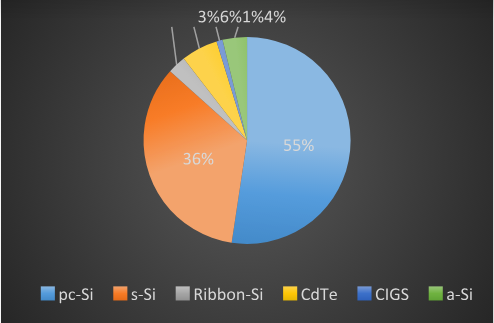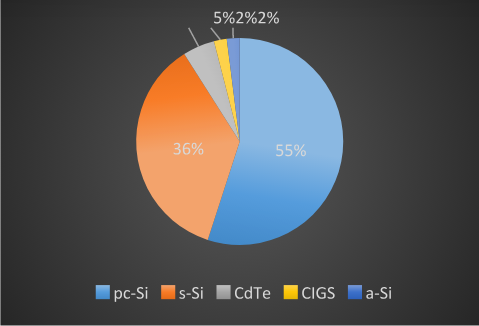4.4 Progress & trends in the market share of s-Si and pc-Si solar PVs

Solar PV is an ever-evolving, ever-changing technology where researchers keep improving the light-harvesting efficiency. Researchers have also been developing new species of solar PV with the intention of making more cost-effective, environmental benign solar PVs. Hundreds of different solar PV technologies have already been developed. However, only crystalline silicon (single crystalline and polycrystalline) and thin-film solar PV (CdTe, CIGS, a-Si) technologies meet the requirements needed for cost-effective, terrestrial-based electricity generation.
Crystalline silicon solar cells are incredibly long-lasting, cost-effective, environmentally friendly and reasonably efficient. So, crystalline silicon solar PV has become the most-demanding, highly remunerative PV technology with a market share of more than 90% [1]. While both s-Si and pc-Si solar panels are increasingly being manufactured, shipped and installed, they are competing with each other to protect and defend their place from the others in the fast-expanding PV market. Following pie charts clearly illustrates how these two technologies performed in the PV market in 2014 and 2007.

Figure 01: Market share by different PV technologies in 2007 [2]

Figure 02: Market share by different PV technologies in 2014 [3]
The cumulative contribution of solar PV to global electricity generation increased to 0.9% in 2014 [3]. As can be seen in the above pie charts, both s-Si and pc-Si silicon PV technologies have been able to keep their market share nearly unchanged. However, the market share of a-Si solar PVs has shrunk from 4% to 2% whilst the market share of CIGS solar PVs has doubled from 1% to 2%. Further, the market share of CdTe solar PVs has narrowed down from 6% to 5% as a result of improving efficiency and the falling price of crystalline silicon PVs which led to an extensive demand for crystalline silicon PVs in the market.
Now let’s take a look at figure 03. It illustrates trends in the market share by PV technology in detail, observed from 1990 to 2013. Interestingly, ribbon-Si PV technology has been experiencing the worst trend. Its market share has been fluctuating and has almost vanished by 2012. Market share of s-Si PVs reached a low in 1997 and then gradually increased until 2000 to reach a peak. After 2000, the market share of pc-Si solar PVs has been expanding and outperforming all of its rivals.

Figure 03: Market share by different PV technologies from 1990 to 2013 [4]
s-Si solar PVs are more efficient than their pc-Si counterparts. But efficiency is just one factor one should give thought to before choosing a solar PV system. Capital cost, return on investment (ROI) and payback time, etc. are also crucial factors that we must take into account. Price of pc-Si solar PVs has declined sharply during the recent past, especially as a result of the immense Chinese contribution to the solar PV industry. Meanwhile, the efficiency of pc-Si solar PVs has been brought into an acceptable level making pc-Si solar PVs the most cost-effective, most dominant technology in the solar PV industry.
Reference
[1] Lunardi, M. M., Alvarez-Gaitan, J. P., Bilbao, J. I., & Corkish, R. (2018). A Review of Recycling Processes for Photovoltaic Modules. In Solar Panels and Photovoltaic Materials. IntechOpen.
[2] Tao, M. (2008). Inorganic photovoltaic solar cells: silicon and beyond. The Electrochemical Society Interface, 17(4), 30-35.
[3] Ramanujam, J., Verma, A., González-Díaz, B., Guerrero-Lemus, R., del Canizo, C., Garcia-Tabares, E. & Rath, J. (2016). Inorganic photovoltaics–planar and nanostructured devices. Progress in Materials Science, 82, 294-404.
[4] By Own work. – Fraunhofer ISE, Report, current editiondata from archived edition, July 28, 2014, page 18, Public Domain, https://commons.wikimedia.org/w/index.php?curid=35756530
